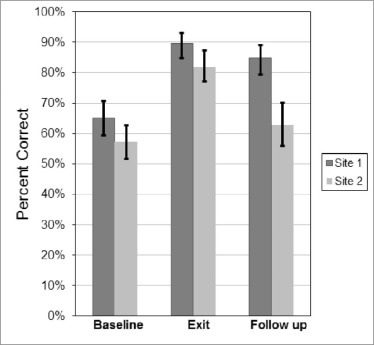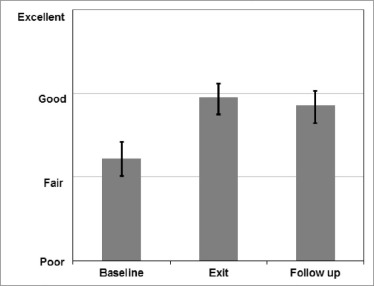Rationale and Objectives
This study aimed to evaluate the effectiveness of an iPad app for teaching healthcare economics milestones.
Materials and Methods
Institutional review board-approved, Health Insurance Portability and Accountability Act-compliant survey assessment of radiology residents’ knowledge of healthcare economics before and following review of the Healthcare Economics iPad app was undertaken at two residencies. Residents received an electronic link to the pre survey, answered 13 general knowledge questions, rated their knowledge of healthcare economics milestones, and reported any prior economics/business background. During the conference, residents reviewed the app on their iPads. They then received a link to the post survey. Responses were entered using REDCap and a unique yet anonymous code was used to link each resident’s pre and post results. A follow-up survey was completed at 3 months using REDCap.
Results
Sixty-two of 69 (90%) residents completed the pre survey. Mean and median age was 30 years. Thirty-two of 62 (52%) were men and 30/62 (48%) were women. Twenty-nine percent (18/62) were postgraduate year (PGY) 2, 24% (15/62) PGY 3, 19% (12/62) PGY 4, 26% (16/62) PGY 5, and 1.6% (1/62) PGY 6. Thirty-four percent (21/62) reported some economics/business background. Residents’ mean self-assessment of their knowledge of healthcare economics milestones was fair on the pre survey, significantly improved on the post survey, and plateaued at 3 months. Fifty-nine residents completed the post survey; 60 completed the 3-month follow-up. Residents demonstrated a significant increase in healthcare economics knowledge on post survey. At 3-month follow-up, significant decreases in gained knowledge were observed only in residents for whom the material was not integrated into the curriculum.
Conclusions
Teaching with iPad apps offers an alternative, effective way to teach basics of healthcare economics milestones.
Introduction
Healthcare economics is now one of the Accreditation Council for Graduate Medical Education (ACGME) radiology milestones and thus has become a required component of residency education. However, most physician educators are not well prepared to teach the principles of economics and business as it applies to the practice of radiology. This topic also does not lend itself to “at the workstation” teaching, as it is not frequently addressed during a clinical workday. For these reasons, teaching of healthcare economics is quite variable among residency programs . A variety of resources have been employed to teach healthcare economics, ranging from journal articles , to online lectures , to formal curricula taught by business educators and other experts in the field . Nonetheless, a recent survey of radiology trainees highlights the significant gaps in healthcare economics knowledge, as most could not estimate imaging costs within 50% of accepted Medicare fees .
Recent educational research has highlighted differences in learning styles for the current generation of trainees, most of whom are millennials (>18 years of age in 2000 or later) . This generation has grown up amid rapidly changing technology, and witnessed the marked increase in tablet use since the iPad was first introduced in 2010. Many healthcare professionals are using iPads and other tablets at work, with reports up to 79% . Not surprisingly, iPad use in radiology education has been reported and will likely continue to grow. With this in mind, the purpose of the study was to evaluate and validate the utility of an iPad app in teaching the healthcare economics milestones to radiology residents. Specifically, we hypothesized that residents’ healthcareeconomics knowledge would increase relative to baseline after completing the iPad app and that there would be a greater loss of the newly acquired knowledge at 3-month follow-up in residents for whom the iPad curriculum was their only formal exposure to the material as compared to residents for whom the material was integrated as part of their residency program.
Materials and Methods
Get Radiology Tree app to read full this article<
Get Radiology Tree app to read full this article<
Statistical Methods
Get Radiology Tree app to read full this article<
Results
Get Radiology Tree app to read full this article<
Healthcare Economics Questions
Get Radiology Tree app to read full this article<
Get Radiology Tree app to read full this article<
Get Radiology Tree app to read full this article<
Table 1
Interval Change in Percentage of Questions Answered Correctly by Residents at Site 1 and Site 2 at Baseline, Immediately Following Review of iPad App Content, and at 3-month Follow-up
Questions Site Baseline Exit 3-month Follow-up Proportion Correct 95% CI Proportion Correct 95% CI Proportion Correct 95% CI 1. With regard to medical reimbursement, what does RVU stand for? 1 1 — — 0.96 — — 1 — — 2 1 — — 0.91 — — 0.76 2. The “professional component” of radiology reimbursement refers to the fees for: 1 1 — — 0.96 [0.62 1.00] 1 [1.00 1.00] 2 1 [1.00 1.00] 0.97 [0.45 1.00] 0.85 [0.74 0.92] 3. The “technical component” of radiology reimbursement refers to the fees for: 1 1 — — 1 [1.00 1.00] 1 [1.00 1.00] 2 0.89 — — 0.88 — — 0.85 [0.03 1.00] 4. What is the main difference between healthcare payments and regular everyday transactions? 1 0.81 [0.02 1.00] 1 — — 1 — — 2 0.6 [0.01 0.99] 0.88 [0.00 1.00] 0.85 [0.38 0.98] 5. In healthcare payment terminology, who is typically referred to as the second party? 1 0.11 [0.04 0.30] 0.96 [0.77 1.00] 0.89 [0.70 0.96] 2 0.29 [0.16 0.46] 0.84 [0.67 0.93] 0.51 [0.35 0.68] 6. What are the two main healthcare reimbursement models? 1 0.78 [0.59 0.89] 0.95 [0.79 0.99] 0.88 [0.71 0.96] 2 0.76 [0.58 0.88] 0.76 [0.57 0.88] 0.61 [0.44 0.75] 7. What is the resource-based relative value scale (RBRVS)? 1 0.63 [0.43 0.79] 0.82 [0.64 0.92] 0.81 [0.65 0.91] 2 0.51 [0.36 0.67] 0.6 [0.43 0.75] 0.35 [0.20 0.54] 8. Adjustments to RBRVS depend on which body or bodies? 1 0.6 [0.41 0.77] 0.71 [0.53 0.84] 0.77 [0.58 0.89] 2 0.25 [0.12 0.43] 0.76 [0.59 0.88] 0.58 [0.42 0.73] 9. Which of the following is NOT part of the total relative value unit (RVU) formula when calculating healthcare payments? 1 0.46 [0.28 0.64] 0.9 [0.76 0.97] 0.76 [0.58 0.88] 2 0.18 [0.09 0.34] 0.89 [0.71 0.96] 0.3 [0.17 0.47] 10. Which healthcare payment formula factor adjusts for geographic differences in cost? 1 0.62 [0.43 0.78] 0.93 [0.76 0.98] 0.83 [0.65 0.93] 2 0.69 [0.53 0.81] 0.81 [0.64 0.91] 0.62 [0.45 0.76] 11. Which of the following is the standardized way to communicate about particular procedures among healthcare providers and payment processors? 1 0.55 [0.37 0.72] 0.88 [0.71 0.95] 0.83 [0.66 0.92] 2 0.44 [0.29 0.60] 0.89 [0.71 0.96] 0.74 [0.56 0.87] 12. Which healthcare payment factor is adjusted to control spending by CMS on Medicare physician services as part of the SGR? 1 0.63 [0.43 0.79] 0.98 [0.88 1.00] 0.85 [0.64 0.95] 2 0.66 [0.48 0.80] 0.84 [0.65 0.94] 0.66 [0.46 0.81] 13. What is the conversion factor for 2014? 1 0.34 [0.19 0.54] 0.65 [0.45 0.81] 0.53 [0.34 0.71] 2 0.27 [0.15 0.43] 0.68 [0.49 0.82] 0.46 [0.30 0.64]
CMS, Center for Medicare and Medicaid Services; SGR, Medicare Sustainable Growth Rate.
Get Radiology Tree app to read full this article<
Get Radiology Tree app to read full this article<
Get Radiology Tree app to read full this article<
Discussion
Get Radiology Tree app to read full this article<
Get Radiology Tree app to read full this article<
Get Radiology Tree app to read full this article<
Get Radiology Tree app to read full this article<
Get Radiology Tree app to read full this article<
Appendix
Supplementary material
Get Radiology Tree app to read full this article<
Appendix S1
Get Radiology Tree app to read full this article<
Get Radiology Tree app to read full this article<
Get Radiology Tree app to read full this article<
Get Radiology Tree app to read full this article<
References
1. ABR : The Diagnostic Radiology Milestone Project. Available at: https://http://www.acgme.org/acgmeweb/Portals/0/PDFs/Milestones/DiagnosticRadiologyMilestones.pdf Accessed September 21, 2015
2. Medverd J.R., Dicks D.L., Tang J., et. al.: Business of radiology 101: the state of radiology business practice and health care policy curricula at US radiology residency programs. J Am Coll Radiol 2012; 9: pp. 174-180. e1 22386163
3. Lam D.L., Medverd J.R.: How radiologists get paid: resource-based relative value scale and the revenue cycle. AJR Am J Roentgenol 2013; 201: pp. 947-958. 24147463
4. Silva E.: Econ speak 101. J Am Coll Radiol 2014; 11: pp. 343-344. 24697995
5. Yousem D.: Business of radiology. Available at: http://webcast.jhu.edu/Mediasite/Catalog/Full/7e18b7d59c63487eaaf177a86f83b01121 Accessed October 1, 2015
6. Prober A.S., Ledermann E., Norbash A., et. al.: Fulfilling the health care economics milestones: adopting an online curriculum for radiology residency programs. J Am Coll Radiol 2015; 12: pp. 314-317. 25743927
7. Gunderman R.B., Tawadros A.M.: Business education for radiology residents: the value of full-time business educators. Acad Radiol 2011; 18: pp. 645-649. 21411344
8. DeQuesada I.M., Chokshi F.H., Mullins M.E., et. al.: Practice management and health policy education in radiology: an emerging imperative. J Am Coll Radiol 2015; 12: pp. 1085-1092. 26118664
9. Vijayasarathi A., Hawkins C., Hughes D., et. al.: How much do common imaging studies cost? A nationwide survey of radiology trainees. AJR Am J Roentgenol 2015; 205: pp. 929-935.
10. Slanetz P.J., Kung J., Eisenberg R.L.: Teaching radiology in the millennial era. Acad Radiol 2013; 20: pp. 387-389. 23452486
11. Howe N., Strauss W.: Millennials rising: the next great generation.2000.VintageNew York
12. Martino A.: There’s an app for that—using iPads for image interpretation. iPad + RAD = ? Is the tablet radiology’s next game changer?. ACR Bull 2011; 66: pp. 16-18.
13. Korbage A.C., Bedi H.S.: The iPad in radiology resident education. J Am Coll Radiol 2012; 9: pp. 759-760. 23025875
14. Korbage A.C., Bedi H.S.: Mobile technology in radiology resident education. J Am Coll Radiol 2012; 9: pp. 426-429. PubMed PMID: 22632670
15. Sharpe E.E., Kendrick M., Strickland C., et. al.: The Radiology Resident iPad Toolbox: an educational and clinical tool for radiology residents. J Am Coll Radiol 2013; 10: pp. 527-532. PubMed PMID: 23647869
16. Berkowitz S.J., Kung J.W., Eisenberg R.L., et. al.: Resident iPad use: has it really changed the game?. J Am Coll Radiol 2014; 11: pp. 180-184. PubMed PMID: 23809171
17. Harris P.A., Taylor R., Thielke R., et. al.: Research Electronic Data Capture (REDCap)—a metadata-driven methodology and workflow process for providing translational research informatics support. J Biomed Inform 2009; 42: pp. 377-381. 18929686 PubMed Central PMCID: PMC2700030
18. McDaniel M.A.: Put the SPRINT in knowledge training with Spacing, Retrieval, and INTerleaving.Healy A.F.Bourne L.E.Training cognition: optimizing efficiency, durability, and generalizability.2012.Psychology PressNew York:pp. 267-286.
19. Craik F.I., Lockhart R.S.: Levels of processing: a framework for memory research. J Verbal Learning Verbal Behav 1972; 11: pp. 671-684.

